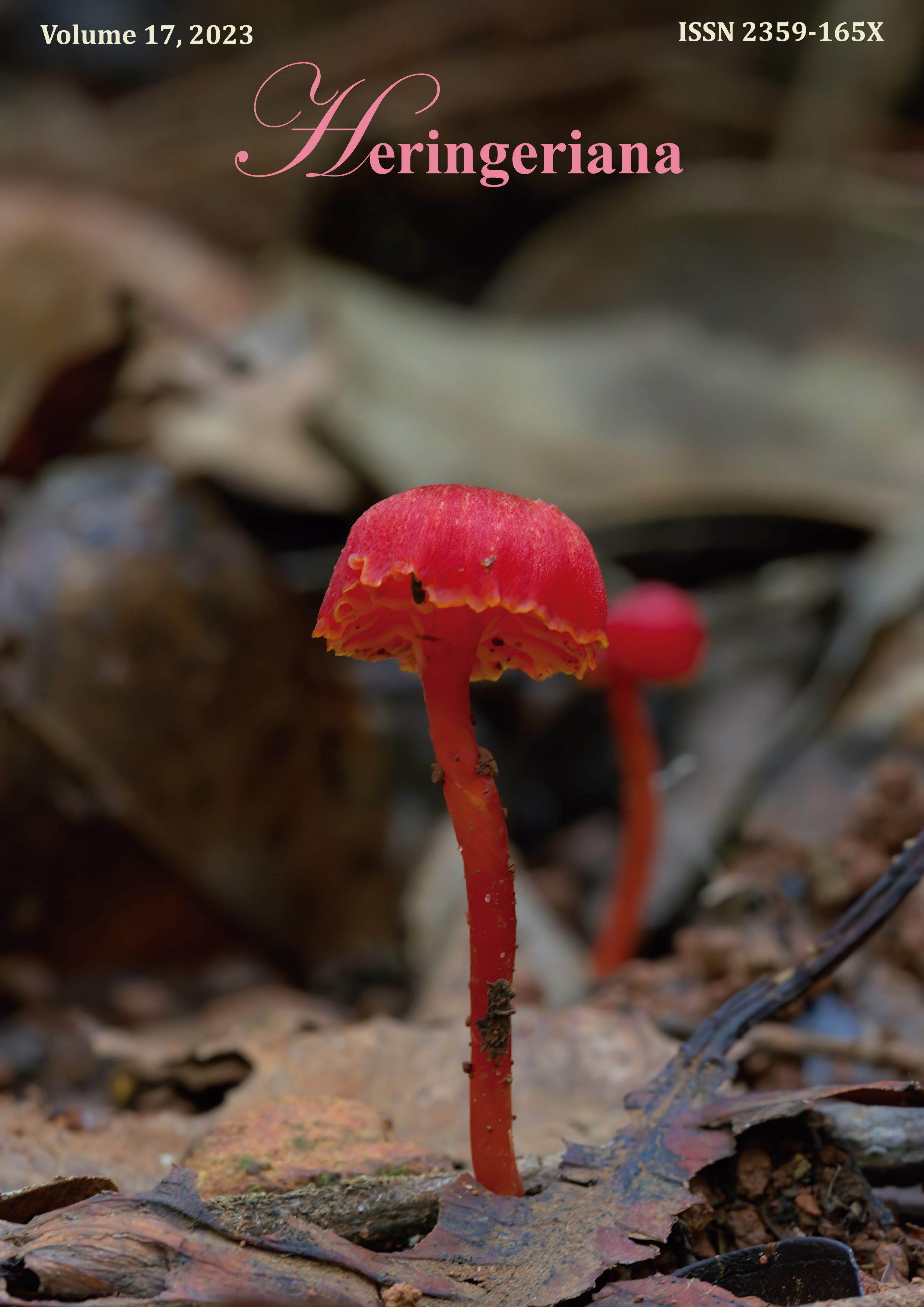Myxomycetes associated with pecan walnut leaf litter, Carya illinoinensis (Wangenh.) K. Koch (Juglandaceae)
DOI:
https://doi.org/10.17648/heringeriana.v17i1.918017Palavras-chave:
Amebozoa, Microhabitat, Phytopathology, ProtistResumo
The pecan tree (Carya illinoinensis, Juglandaceae) was introduced in Brazil at the beginning of the 20th century by American immigrants and its cultivation currently extends from Rio Grande do Sul to Minas Gerais states, with approximately 2,400 hectares planted. We present the first report of litter-associated myxomycetes of C. illinoinensis, directly observed in the field, sporulating on dry leaves (Physarum cinereum, P. melleum, P. polycephalum), twigs and dry leaves (Diachea leucopodia) and twigs (Fuligo cinerea, F. septica, Hemitrichia serpula var. serpula). The most constant species were P. melleum and D. leucopodia. Fuligo cinerea is recorded for the first time for Rio Grande do Sul; D. leucopodia and P. cinereum are cited for the first time for the Brazilian portion of the Pampa, bringing the number of species known for the biome to 61.
Referências
Agra, L.A.N.N., Seixas, C.D.S. & Dianese, J.C. (2018) False bean smut caused by slime mold. Plant Disease 102:507-510. https://doi.org/10.1094/PDIS-06-17-0831-RE
Alfaro, J.R.D., Alcayde, D.L.I.M., Agbulos, J.B., Dagamac, N.H.A. & Cruz, T.E.E. (2014) The occurrence of myxomycetes from a lowland montane forest and agricultural plantations of Negros Occidental, Western Visayas, Philippines. FineFocus 01:07–20. https://doi.org/10.33043/FF.1.1.7-20
Araújo, J.C., Moreira, I.C. & Xavier-Santos, S. (2014) Myxobiota associada a resíduos de Mangueira (Mangifera indica L., Anacardiaceae). Heringeriana 6(1):20–22. https://doi.org/10.17648/heringeriana.v6i1.13
BFG. (2022) Brazilian Flora 2020: Leveraging the power of a collaborative scientific network. Taxon 71:178-198.
Backes, P. & Irgang, B. (2004) Árvores do Sul. Guia de identificação & interesse ecológico. As principais espécies nativas Sul-Brasileiras. Instituto Souza Cruz, Santa Cruz do Sul, 204 pp.
Berestetskaya, L.I. (1998) The mycomycete Fuligo septica on strawberry. Zashchita i Karantin Rastenii 10: 28.
Bezerra, A.C.C. & Cavalcanti, L.H. (2007) Mixobiota corticícola em Terminalia catappa L. (Combretaceae). Sitientibus Série Ciências Biológicas 7: 154-160. https://doi.org/10.13102/scb8116
Bezerra, A.C.C., Cavalcanti, L.H. & Dianese, J.C. (2009) Species of Hemitrichia (Trichiaceae, Myxomycetes) in Brazil. Mycotaxon 107:35-48. https://doi.org/10.5248/107.35
Bezerra, A.C.C., Costa, A.A.A. & Cavalcanti, L.H. (2011) Myxomycetes occurring on Cecropia adenopus (Cecropiaceae) in fragments of Atlantic Rainforest. Acta Botânica Brasilica 25:11-16. https://doi.org/10.1590/S0102-33062011000100003
Buisan, P.N.H.N., Abu, D., Catipay, J.P., Dango, C.J., Supremo, J. & Dagamac, N.H. (2020) Documenting the first records of myxomycetes on Rice litter of Cotabato, Southern Mindanao, Philippines. Karstenia 58:250-259. https://doi.org/10.29203/ka.2020.498
Cabrera-de-Alvarez, M.G., Mazzanti-de-Castanon, M.A, Cundom, M.A. (1993) Suffocation of tomato seedings by a true slime mold (Myxomycetes) in the northeast of Argentina. Fitopatologia 28:10-15.
Cavalcanti, L.H. & Mobin, M. (2004) Myxomycetes associated with palm trees at the Sete Cidades National Park, Piauí State, Brazil. Systematics and Geography of Plants 74:109-127.
Cavalcanti, L.H., Bezerra, A.C.C., Costa, A.A.A., Ferreira, I.N. & Bezerra, M.F.A. (2009) Distribution of Diachea (Didymiaceae, Myxomycetes) in the northeastern region of Brazil. Mycotaxon 110:163–172. https://doi.org/10.5248/110.163
Cavalcanti, L.H., Damasceno, G., Bezerra, A.C.C. & Costa, A.A.A. (2014) Mangrove myxomycetes: species occurring on Conocarpus erectus L. (Combretaceae). Sydowia 66:183-190. 10.12905/0380.sydowia66(2)2014-0183
Cavalcanti, L.H., Damasceno, G., Costa, A.A.A., Bezerra, A.C.C. (2016) Myxomycetes in Brazilian mangroves: species associated with Avicennia nitida, Laguncularia racemosa and Rhizophora mangle. Marine Biodiversity Records 9:31-37. https://doi:10.1186/s41200-016-0035-4
Crescenzi, A., Rana, G.L., Fanigliulo, A., Lahoz, E. & Carrieri, R. (2015) First Report of Physarum cinereum on Lettuce, Rocket, Endive, and Celery in Italy. Plant Disease 99:1272. https://doi.org/10.1094/PDIS-11-14-1121-PDN
Domingues, R.J., Tofoli, J.G., Ferrari, J.T. & Nogueira, E.M.C. (2012) Primeiro registro de ocorrência de Diachea leucopodia (Bull.) Rostaf. (1874) em cultivo de morangueiro no Brasil. Documento Técnico do Instituto Biológico de São Paulo 1-9.
Duarte, V. & Ortiz, E.R.N. (2001) Podridão de Phytophora da amêndoa e da casca da nogueira pecan. In: Luz, E.D.M.N. et al. (Ed.). Doenças causadas por Phytophora no Brasil. Campinas: Rural, pp. 493-508.
Dudka, I.O. & Romanenko, K.O. (2006) Co-existence and interaction between Myxomycetes and other organisms in shared niches. Acta Mycologica 41:99-112. https://doi.org/10.5586/am.2006.014
Farr, M.L. (1976) Myxomycetes. Flora Neotropica, New York, 304 pp.
Fronza, D., Poletto, T. & Hamann, J.J. (2013) O cultivo de nogueira-pecan. UFSM, Santa Maria, 301 pp.
Fukasawa, Y., Hyodo, F. & Kawakami, S. (2018) Foraging associations between myxomycetes and fungal communities on coarse wood debris. Soil Biology and Biochemistry 121:95-102. https://doi.org/10.1016/j.soilbio.2018.03.006
IBGE. Instituto Brasileiro de Geografia e Estatística (2020) https://cidades.ibge.gov.br/brasil/rs/sao-gabriel/
Keller, H.W, Everhart, E.S & Kilgore, C.M. (2022) The myxomycetes: introduction, basic biology, life cycles, genetics, and reproduction. In: Rojas, C. & Stephenson, S.L. (Eds.) Myxomycetes: Biology, Sistematics, Biogeography and Ecology. 2 ed., London, Academic Press, pp. 1-45.
Kim, W.G., Lee, S.Y. & Cho, W.D. (2007) Two species of myxomycetes causing slime mold of sweet potato. Mycobiology 35:97-99.
Kirschner, R., Villarreal, S.R.V., Vega, J.A.B. (2017) First record of association of gall midges (Cecidomyiidae, Diptera) with a slime mold (Fuligo candida, Myxomycetes) in the tropics. Tropical Ecology 58:667-672.
Laaksonen, M., Murdoch, K., Siitonen, J. & Várkonyi, G. (2010) Habitat associations of Agathidium pulchellum, an endangered old-growth forest beetle species living on slime moulds. Journal Insect conservation 14:89-98.
Lado, C. (2005–2022) An online nomenclatural information system of Eumycetozoa. Available in: https://eumycetozoa.com/data/index.php (Accessed: 1 Jun 2022).
Lee, J.H., Han, K.S., Bae, D.W., Kim, D.K. & Kim, H.K. (2008) Identification of Diachea leucopodia on Strawberry from Greenhouse in Korea. Mycobiology 36:143-147.
Lemos, D.B.N., Agra, L.A.N.N., Iannuzzi, L., Bezerra, M.F.A. & Cavalcanti, L.H. (2010) Co-existence of myxomycetes and beetles in an Atlantic Rainforest remnant of Pernambuco, Brazil, with emphasis on Staphylinids (Coleoptera: Staphylinidae). Journal of Natural History 44:1365-1376. https://doi.org/10.1080/00222931003632724
Maimoni-Rodella, R.C.S. & Cavalcanti, L.H. (2006) Myxomycetes sobre inflorescências e folhas vivas de lírio-do-brejo (Hedychium coronarium Koenig, Zingiberaceae): registro de um novo substrato. Revista Brasileira de Botânica 29:331-333. https://doi.org/10.1590/S0100-84042006000200014
Marchiori, J.N.C. (1997) Dendrologia das angiospermas: das magnoliáceas às flacurtiáceas. Editora da UFSM, Santa Maria, 271 pp.
Martin, G.W. & Alexopoulos, C.J. (1969) The Myxomycetes. University of Iowa Press, Iowa, 561 pp.
Mckenzie, E.H C. (1992) Fungi of the Kermadec Islands. Mycotaxon 45:149-170.
McWilliams, J. (2013) The pecan: A history of America’s native nut. Hardcover, Austin, 178 pp.
Mendes, M.A.S., Ferreira, M.A.S. V., Dianese, J.C., Santos, C.E.N., Urben, A.F. & Castro, C. (1998) Fungos em plantas no Brasil. Embrapa-SPI/Embrapa Cenargen, Brasília, 555 pp.
Mendes, M.A.S. & Urben, A.F. (2022) Fungos relatados em plantas no Brasil. Laboratório de Quarentena Vegetal, Brasília, DF. Embrapa Recursos Genéticos e Biotecnológicos. Available in: http://pragawall.cenargen.embrapa.br/aiqweb/michtml/fgbanco01.asp. (Accessed: 31/5/2022).
Muchovej, J.J. & Muchovej, R.M.C. (1987) Physarum cinereum on turfgrass in Brazil. Fitopatologia brasileira 12:401-3.
Parente, M.P.M. & Cavalcanti, L.H. (2013) Myxomycetes on palm trees: species on Attalea speciosa Mart. ex Spreng. Advances in Microbiology 3: 19-23. DOI: 10.4236/aim.2013.38A004
Poletto, T., Muniz, M.F.B., Poletto, I., Stefenon, V.M., Maciel, C.G. & Rabusque, J.E. (2016) Dormancy overcome and seedling quality of pecan in nursery. Ciência Rural 46:1980-1985. https://doi.org/10.1590/0103-8478cr20150835
Poulain, M., Meyer, M., Bozonnet, J. (2011) Les Myxomycètes. Fédération Mycologique et Botanic Dauphiné-Savoie, Sévrier, 1119 pp.
Redeña-Santos, J.C., Dunca, J.A.U., Thao, D.V. & Dagamac, N.H.A. (2017) Myxomycetes occurring on selected agricultural leaf litters. Studies in Fungi 2: 171-177. https://doi.org/10.5943/sif/2/1/19
Reed, C.A. & Davidson, J. (1954) The improved nut trees of North America and how to grow them. Devin-Adair Publishing Company, New York, pp 128-158.
Ribeiro, N. & Brioso, P.S.T. (2019) Detecção de Myxomycetes em morangueiro no sul de Minas Gerais. Summa Phytopathologica 45:340-341. https://doi.org/10.1590/0100-5405/189721
Rodrigues, C.L.M. & Guerrero, R.T. (1990) Myxomycetes do Morro Santana, Porto Alegre, Rio Grande do Sul. Boletim do Instituto de Biociências 46:1-102.
Sá, C.E.V.A., Ferraz, L.G.B. & Cavalcanti, L.H. (2019) Mixomicetos associados a coqueiro (Cocos nucifera L.) na Estação Experimental de Itapirema (Goiana, Pernambuco, Brasil). Pesquisa Agropecuária Pernambucana 24:1-7 https://doi.org/10.12661/pap.2019.007
Sá, C.E.V.A., Ferraz, L.G.B. & Cavalcanti, L.H. (2022) Assemblanges of Myxomycetes associated with de Cocos nucifera L. trees. Acta Brasiliensis 6:35-42 https://doi.org/10.22571/2526-4338587
Santos, E.J. & Cavalcanti, L.H. (1991) Mixomicetos do canavial: I - Levantamento florístico em Carpina, Pernambuco. Acta Botanica Brasilica 5: 49-61. https://doi.org/10.1590/S0102-33061991000100004
Schnittler, M., Heherson, N., Dagamac, A., Woyzichovski, J., Novozhilov, Y.K. (2022) Biogeographical patterns in Myxomycetes. In: Rojas, C. & Stephenson, S.L. (Eds.) Myxomycetes: Biology, Sistematics, Biogeography and Ecology. 2 ed., London, Academic Press, pp. 377-416.
Silva, G.F. & Bezerra, J.L. (2005) Occurence of Fuligo septica on lettuce and long coriander. Fitopatologia Brasileira 30:439. https://doi.org/10.1590/S0100-41582005000400024
Silva, G.S., Ferreira, I.C.M. & Bitencourt, N.V. (2008) Novos hospedeiros de Fuligo septica no Estado do Maranhão. Summa Phytopathologica 34:97. https://doi.org/10.1590/S0100-54052008000100025
Silva, C.F. & Cavalcanti, L.H. (2010) Myxobiota of the Brazilian Atlantic Forest: Species on Oil Palm Tree (Elaeis guineensis, Arecaceae). Rodriguésia 61: 575-583. https://doi.org/10.1590/2175-7860201061402
Silva, N.A. & Cavalcanti, L.H. (2012) Myxomycetes ocorrentes em áreas de caatinga e brejo de altitude no sertão de Pernambuco, Brasil. Acta Botanica Brasilica 26: 901-915. https://doi.org/10.1590/S0102-33062012000400019
Tran, H.T.M., Stephenson, S.L., Hyde, K. D., & Mongkolporn, O. (2008) Distribution and occurrence of myxomycetes on agricultural ground litter and forest floor litter in Thailand. Mycologia 100:181-190. https://doi.org/10.1080/15572536.2008.11832475
Velloso, J.R.P., Heberle, M.A & Putzke, J. (2020) Myxomycetes (Protista, Amebozoa) no Rio Grande do Sul. Arrudea 6:15-26. http://dx.doi.org/10.55513/arrudea0042
Wordell Filho, J.A. & Boff, P. (2006) Doenças de origem parasitária. Pp 19-126. In: Wordell Filho, J.A., Rowe, E, Gonçalves, P.A.S., Debarba, J.F., Boff, P. & Thomazelli, L.F. Manejo fitossanitário na cultura da cebola. Florianópolis, Epagri pp 19-126.
Wrege, M.S., Steinmetz, S., Garrastazu, M.C., Reisser Júnior, C., Almeida, I.R., Herter, F.G., Caramori, P.H., Radin, B., Matzenauer, R.., Braga, H.J., Prestes, S.D., Cunha, G.R., Maluf, J.R.T. & Pandolfo, C. (2011) Atlas climático da região sul do Brasil: estados do Paraná, Santa Catarina e Rio Grande do Sul. Embrapa Clima Temperado, Pelotas, 332 pp.
Xavier de Lima, V. & Cavalcanti, L.H. (2017) Diversity and ecology of Myxomycetes in the Pampa Biome, Brazil. Nova Hedwigia 104:273-291. DOI: 10.1127/nova_hedwigia/2016/0360
Downloads
Publicado
Como Citar
Edição
Seção
Licença
Copyright (c) 2023 Jorge Renato Pinheiro Velloso, Jair Putzke, Laise de Holanda Cavalcanti

Este trabalho está licenciado sob uma licença Creative Commons Attribution 4.0 International License.
Ao fazer a submissão, os autores declaram não ter submetido o trabalho a outra revista e concordam em ter seu artigo publicado sob Licença Creative Commons Atribuição 4.0 Internacional BY (CC BY 4.0), que significa que os autores mantêm a propriedade dos direitos autorais, mas qualquer pessoa pode usar o conteúdo publicado, desde que os autores originais e a fonte sejam citados. O conteúdo científico, ortográfico e gramatical é de total responsabilidade dos autores.








